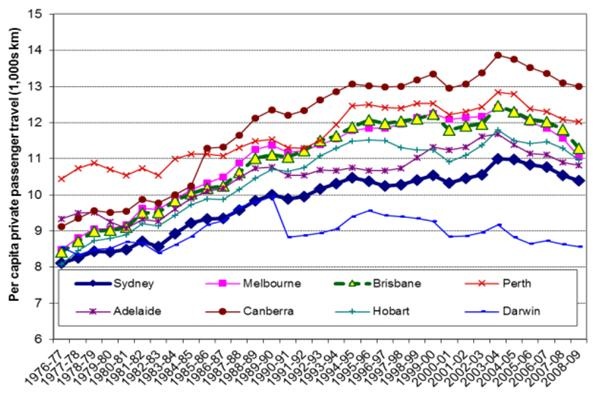Abbott's infrastructure tunnel vision
Opposition leader Tony Abbott said on Monday:
“I would like to think that should we win the election I will be known as an infrastructure prime minister, because we need the infrastructure of the 21st century if we are going to have the prosperity, if we are going to have the productivity that the people of Australia need.”
Yet so far this 21st century vision of Abbott’s seems singularly focussed on 20th century roads.
Abbott is spot on that traffic jams place a major drain on economic productivity and our quality of life. But upgrading roads aren’t the only way to relieve congestion. And as our charts of the week below illustrate, Abbott may be missing some key 21st century trends which illustrate people are starting to move away from roads and towards rail because it’s faster and cheaper.
When asked whether a future Coalition government would help fund a proposed nine kilometre rail tunnel linking Melbourne’s inner northern and southern suburbs (Metro Rail) he said:
“We have no history of funding urban rail and I think it is important that we stick to our knitting and the Commonwealth’s knitting when it comes to funding infrastructure is roads."
What’s interesting is that this Metro Rail project has been subject to a comprehensive cost-benefit analysis reviewed by Infrastructure Australia suggesting it has a 90 per cent probability of providing benefits of at least $1.17 for every $1 in cost and the middle of the road estimate is $1.30 of benefit.
Meanwhile Abbott is enthusiastically backing another entirely urban transport project in Melbourne – the East-West road tunnel. But the business case for this project is yet to be released and Abbott admitted he hasn’t seen it. Nor has it been evaluated by Infrastructure Australia.
While the Napthine Government asserts it will provide $1.40 of benefit for each $1, this is subject to some dispute. Transport and Urban Design analyst Alan Davies, citing the Eddington Melbourne Transport Study (which recommended both the rail and road projects proceed), suggests it may be closer to $0.50 benefit to $1 in cost.
Irrespective of these claims and counter claims, one has to ask why Abbott enthusiastically backs a road project business case unseen, while rejecting a rail project with a strong business case subjected to independent scrutiny. Both projects serve precisely the same purpose – increasing transport capacity and reducing travel time in urban Melbourne. Neither serves the purpose of interstate travel or freight.
This isn’t about some kind of greenie public transport obsession. Jeff Kennett, former Victorian Liberal premier, told Fairfax media a few days ago that an expanded metro rail network was Melbourne's top infrastructure priority pointing out that, ''There's not a major world city that doesn't have one.''
You don’t have to be a genius to come to similar conclusions to Kennett.
Patronage on Melbourne’s rail network has increased 70 per cent over the last 10 years and by 40 per cent over the last five. It is in desperate need of investment to cope with demand.
What Abbott may not realise is that in the 21st century we’ve seen a reversal of a 20th century trend towards increasing use of car travel in Australian cities, and indeed other cities around the world.
In a paper entitled, Peak car use and the rise of global rail, researchers Peter Newman, Jeffrey Kenworthy and Garry Glazebrook explain how the use of cars is reaching saturation point in cities and travel is switching to rail.
The chart below from their paper shows how per capita private passenger car travel in Australian cities has begun declining since just after the turn of the century.

Source: Newman, Kenworthy and Glazebrook (2013) Peak car use and the rise of global rail
At the same time, in Melbourne, Perth and Brisbane where public transport and particularly rail represent a reasonable alternative to cars, usage experienced a noticeable uptick. Although car travel still vastly outweighs public transport.
According to the researchers, this is a product of Australian as well as US and Canadian cities' populations reaching physical limits that constrain travel time by motor vehicles, in conjunction with rising petrol prices. The chart below illustrates how train travel time is becoming faster relative to cars over time.

Source: Newman, Kenworthy and Glazebrook (2013) Peak car use and the rise of global rail
This is not to say that Abbott shouldn’t be considering funding upgrades to roads in Australian cities. But the more population-dense Australian cities of the 21st century require an approach that thoroughly evaluates all the transport options, including rail, but also greater use of road pricing.
















